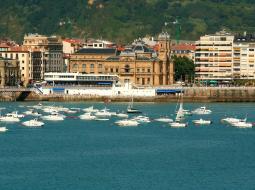Thessaloniki gets ready for its metro launch in November
The underground rapid transit lines have been under construction for almost two decades due to various project delays
 TheMayor.EU logo
TheMayor.EU logo 
The first written mention of San Sebastián refers to a monastery San Sebastián El Antiguo which in the eleventh and twelfth centuries was the centre of a nascent social and administrative life. San Sebastián was founded around 1180 by Sancho el Sabio, king of Navarre with the goal of it becoming the main seaport of Navarre. San Sebastián is believed to have later been conquered by Castile. The change meant that Donostia went from being the port of a small state lacking the prospects of territorial expansion to the sea outlet of a rich monarchy in its height.
The Kings of Castile fought for the first time with the naval forces of San Sebastián in 1248. Alfonso VIII began granting a long list of privileges to San Sebastián, trying to keep the Navarrese traffic alive and preserve a privileged situation of the San Sebastian merchants in the Spanish market.
The Hundred Years War and the choice of Navarra to throw its weight behind the French San Sebastián in the second half of the 14th century. Among them, the displacement of the main trade lines towards Bilbao. In January 1489 a fire reduced the town to ashes.
From the last quarter of the fifteenth century, San Sebastián went from being a commercial centre to a naval base. The maritime force stationed there keeps up the fight against the French, Dutch and British until the 19th century. After two centuries of heroically fulfilling its military mission, Felipe IV granted San Sebastian the status of City in 1662. During the War of Independence, San Sebastián was occupied in 1808 by Napoleonic troops.
With the death of King Alfonso XII of Spain in 1885, his widow, Queen Regent María Cristina, moved the court to San Sebastián every summer and resided in the Miramar Palace.
In 1914 with the beginning of WWI, San Sebastián became the most cosmopolitan city in Europe. Famous figures, including Mata Hari, Leon Trotsky, Maurice Ravel met within its confines.
In 1930, the city hosted the meeting of Republican politicians who called themselves the Pact of San Sebastián, which had great significance in the subsequent advent of the Second Republic on April 14, 1931. Shortly after the Spanish Civil War broke out, San Sebastián fell into the hands of the coup plotters in 1936. The regime of Francisco Franco kept San Sebastián as a Capital City of Veraneo. One year after his death in 1978 the first democratic municipal elections were organized.
San Sebastian is a city and municipality in Spain, in the Basque autonomous community. It is the capital of Guipúzcoa province and a centre of the Basque language Euskara.
The municipality of San Sebastian is divided into 20 neighbourhoods. The current population of the city is of 186 370 persons, the number reaching 436 500 with the metropolitan population.
Without any doubt, the driving force of the local economy is the tourism sector. Ever since the Spanish Royal Court chose it as a place of rest in the summer, tourism has been strong in San Sebastian. The trade sector remains of significance as well as the city is an attractive shopping destination 20 kilometres away from the border with France.

Donostia or San Sebastián is a city perched on the sea with several sandy beaches. With 18 Michelin star restaurants, it is recognized worldwide for its fine cuisine and the pintxos bars. The famous "International Film Festival" of San Sebastian is a top event for cinema enthusiasts. The must-see attractions include the Aquarium (El Palacio del Mar), the Old town and the City Council building. The Camino de Santiago hiking and mountain biking tours pass through San Sebastian as well.
The city’s tourism offer has received the following distinctions:
Ijentea 1, 20003 Donostia / San Sebastián
(+34) 943 481000